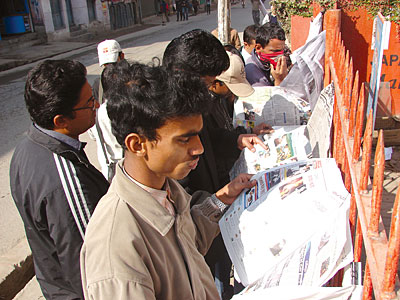 |
Eleven hours of load shedding have played havoc with the evening schedule of the Nepali middle class. Affluent television addicts have opted for massive inverters. But the rest of us have to either put up with FM banter or scan pages under candlelight.
Since prime time coincides with the heaviest power cuts, major advertisers are reluctant to pay a premium for ad spots. The trend is not yet fully visible, but a sizable section of the audience and advertisers has begun to patronise the print media.
Diesel-run generators are expensive, and the publishers compelled to use them have no reason to be grateful to Nepal Electricity Authority for a sudden jump in circulation. But newspapers and magazines will certainly need to improve on quality if they are to retain new readers who will have the option of going back to television once the power supply improves.
Where regular reporting is concerned - who did or said what - newspapers can\'t compete with radio, television or the Internet. By the time the morning papers arrive, the talking heads of the evening shows will have already torn every event of any significance apart. But the priorities of print have tended to be similar to those of television: in an attempt to reach the masses, both emphasise what is urgent rather than what is important.
Papers can add value not only by covering weighty issues but also by making them more interesting. This requires a reorientation of the way print journalism is done.
The Indian newspaper industry is trying to cope with the competition by transforming itself into a clone of the flickering monitor. Even in print, a story these days has to be small enough to fit the cellphone screen, but must have sufficient pictures to hold its own around the breakfast table, where blogs and newsfeeds are competing for attention.
A more sustainable response perhaps would be to do what only print is capable of doing: present news in such a way that it remains news. Newspapers now have to learn to do magazine journalism and magazines have to adopt the techniques of literary reporting. It may not have been by design, but some Nepali publications seem to be adapting successfully.
The cover of the daily Naya Patrika is quintessentially tabloid. Sensational headlines, arresting snippets, unusual pictures and fresh angles on everyday stories make this paper sell like, well, a tabloid. But looks can also be deceptive. Naya Patrika has more in-depth stories for highbrow readers than many ordinary broadsheets. In its centrespreads, talented reporters like Sangitshrota, Pramila and Deepak dig deep into personalities and events with unmatchable literary flair.
The weekend issue of Nagarik daily has its own corps of writers who combine the integrity of facts, the beauty of truth and the drama of a story in their reportage. Buddhisagar, who also happens to be a published poet and a budding novelist, has drawn a picture of rural Kailali so vividly every antic of Laxman Tharu suddenly begins to make sense. Tharus are peripheral to Buddhi\'s story, but he explains the marginalisation of Laxman\'s generation in their own homeland more eloquently than any deliberately sympathetic coverage might.
Sudhir Sharma honed his storytelling techniques at some of the pioneering news magazines of Nepal before becoming the editor of Kantipur daily. His paper is too deep into the respectability groove to allow him to experiment with the so-called literature of facts. However, even the old lady of Subidhanagar recently ran a front page story describing how the palms of the bereaved Moin Shah were colder than the wet hands of the reporter. Great journalism is not only a window, but also a mirror - a reader looks at the world and sees his own reflection through every story.
Objectivity helps the media establish credibility. But a new crop of print journalists has shown that it is subjectivity in reporting that makes a story meaningful and enduring.



